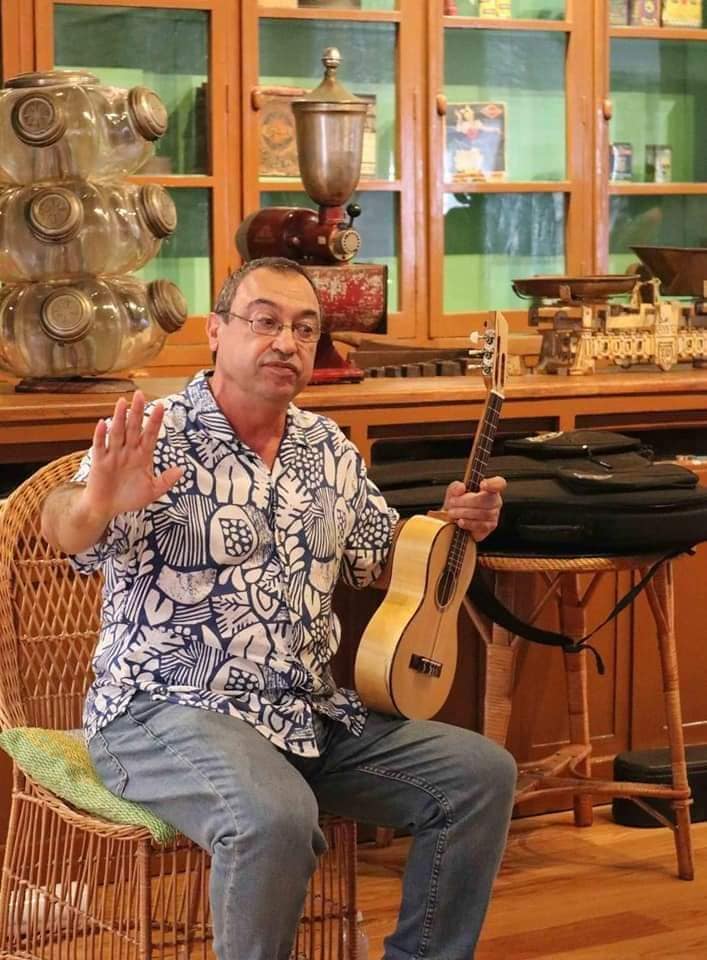This project is coordinated and executed by researcher and musicologist Vítor Sardinha and includes:
Recital (Museum Visitors).
Musical Workshops (1st, 2nd Cycle).
Cultural Promotion.
The Project will be promoted, fortnightly, until June 2022, upon prior registration.
If you are interested in participating in the sessions that will take place at the “Museu Etnográfico da Madeira”, INFORM YOURSELF and REGISTER, through the following contacts:
Tel.: 291 95 2598.
Unique in Portuguese music, “Rajão” also reflects a cultural experience, whether in terms of the instrument's architecture, tuning or geography of its musical practice.
An instrument built, practiced and taught only on Madeira Island, it clashes with the national whole, with its reference chordophones and therefore has to be analyzed and studied, seeking other sources and foundations.
Using the reentrant tuning, common to the Renaissance and Baroque, this simple five-string chordophone is undoubtedly very old, older than the other popular Madeiran string instruments.
But it is not only in mainland Portugal and the Azores that the instrument is not referenced in instrumental practice. There is no Portuguese-speaking country that builds, practices or teaches it.
Manuel Morais, a musicologist with extensive an0d qualified research, mentions in his investigation («A MADEIRA E A MÚSICA - Studies c. 1508- c. 1974» Edition - FUNCHAL 500 YEARS 2008;), some important musicological foundations: «Probably the current “rajão” is a popularized form (which crystallized), in Madeira, of the archaic ''viola requinta'', used at least since the end of the 19th century. XVI, and whose only example is the famous viola of five double orders, built by the Portuguese Belchior Dias in Lisbon in 1581.».
It would be through the emigration from Madeira to the distant islands of Hawaii, that from 1879 onwards another aspect of the instrument was developed (keeping the reentrant tuning), locally known as the Ukulele. On this long boat trip, which took four months, the emigrants from Madeira hired to work in the sugarcane plantations, took with them as travel companions, the three traditional chordophones of the archipelago: “Braguinha”, “Rajão” and “Viola de Arame”. Of the musicians who boarded, one name stands out, João Fernandes and, of the guitar masters, registered in Portugal as carpenters, Manuel Nunes, Augusto Dias and José do Espírito Santo. These four Madeirans were responsible for the visibility of the chordophones of the Madeiran musical tradition in those lands, (still as an American protectorate and not a State) in particular before the last King of Hawaii King Kalakaua and Princess Liliuokalanie.
All three masters opened a workshop and shop selling their instruments, participating in serenades at the royal palace.
The current Hawaiian Ukulele, his national instrument, has the same tuning used by the secular “Rajão” as an open string tuning. Two archipelagos, two cultures, two oceans - in the same chordophone!
To celebrate this musical journey, and its protagonists, the guitar masters and performing musicians who made this historic sharing possible, a specific musical program was designed.
The musical moment, carried out by the musician and musicologist Vítor Sardinha, covers the “Rajão” repertoire, through time (the Renaissance, Baroque and classical periods), the Madeiran Traditional Music and the American songbook repertoire (from swing jazz to the dance music of the 20th century). The idea is to play for those who visit, building a soundtrack in the background.
A second moment of this presence in museums is dedicated to cultural dynamism. In this (aimed at schools, “Casas do Povo”, senior university, local community, among other interested groups), various topics will be discussed in depth, of which we highlight: Madeiran emigration to Hawaii, the construction of instruments, music, practice and islands musical genres, the festive contexts of its presentation, among other curiosities.




